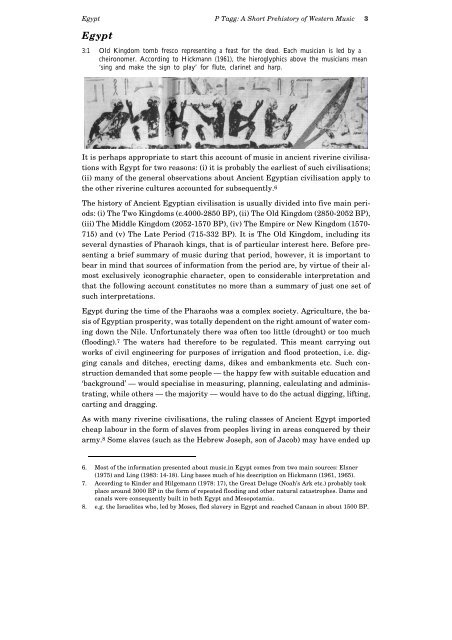A Short Prehistory of Western Music, Chapter 3
A Short Prehistory of Western Music, Chapter 3
A Short Prehistory of Western Music, Chapter 3
You also want an ePaper? Increase the reach of your titles
YUMPU automatically turns print PDFs into web optimized ePapers that Google loves.
Egypt P Tagg: A <strong>Short</strong> <strong>Prehistory</strong> <strong>of</strong> <strong>Western</strong> <strong>Music</strong> 3<br />
Egypt<br />
3:1 Old Kingdom tomb fresco representing a feast for the dead. Each musician is led by a<br />
cheironomer. According to Hickmann (1961), the hieroglyphics above the musicians mean<br />
‘sing and make the sign to play’ for flute, clarinet and harp.<br />
It is perhaps appropriate to start this account <strong>of</strong> music in ancient riverine civilisations<br />
with Egypt for two reasons: (i) it is probably the earliest <strong>of</strong> such civilisations;<br />
(ii) many <strong>of</strong> the general observations about Ancient Egyptian civilisation apply to<br />
the other riverine cultures accounted for subsequently. 6<br />
The history <strong>of</strong> Ancient Egyptian civilisation is usually divided into five main periods:<br />
(i) The Two Kingdoms (c.4000-2850 BP), (ii) The Old Kingdom (2850-2052 BP),<br />
(iii) The Middle Kingdom (2052-1570 BP), (iv) The Empire or New Kingdom (1570-<br />
715) and (v) The Late Period (715-332 BP). It is The Old Kingdom, including its<br />
several dynasties <strong>of</strong> Pharaoh kings, that is <strong>of</strong> particular interest here. Before presenting<br />
a brief summary <strong>of</strong> music during that period, however, it is important to<br />
bear in mind that sources <strong>of</strong> information from the period are, by virtue <strong>of</strong> their almost<br />
exclusively iconographic character, open to considerable interpretation and<br />
that the following account constitutes no more than a summary <strong>of</strong> just one set <strong>of</strong><br />
such interpretations.<br />
Egypt during the time <strong>of</strong> the Pharaohs was a complex society. Agriculture, the basis<br />
<strong>of</strong> Egyptian prosperity, was totally dependent on the right amount <strong>of</strong> water coming<br />
down the Nile. Unfortunately there was <strong>of</strong>ten too little (drought) or too much<br />
(flooding). 7 The waters had therefore to be regulated. This meant carrying out<br />
works <strong>of</strong> civil engineering for purposes <strong>of</strong> irrigation and flood protection, i.e. digging<br />
canals and ditches, erecting dams, dikes and embankments etc. Such construction<br />
demanded that some people — the happy few with suitable education and<br />
‘background’ — would specialise in measuring, planning, calculating and administrating,<br />
while others — the majority — would have to do the actual digging, lifting,<br />
carting and dragging.<br />
As with many riverine civilisations, the ruling classes <strong>of</strong> Ancient Egypt imported<br />
cheap labour in the form <strong>of</strong> slaves from peoples living in areas conquered by their<br />
army. 8 Some slaves (such as the Hebrew Joseph, son <strong>of</strong> Jacob) may have ended up<br />
6. Most <strong>of</strong> the information presented about music.in Egypt comes from two main sources: Elsner<br />
(1975) and Ling (1983: 14-18). Ling bases much <strong>of</strong> his description on Hickmann (1961, 1965).<br />
7. According to Kinder and Hilgemann (1978: 17), the Great Deluge (Noah’s Ark etc.) probably took<br />
place around 3000 BP in the form <strong>of</strong> repeated flooding and other natural catastrophes. Dams and<br />
canals were consequently built in both Egypt and Mesopotamia.<br />
8. e.g. the Israelites who, led by Moses, fled slavery in Egypt and reached Canaan in about 1500 BP.














